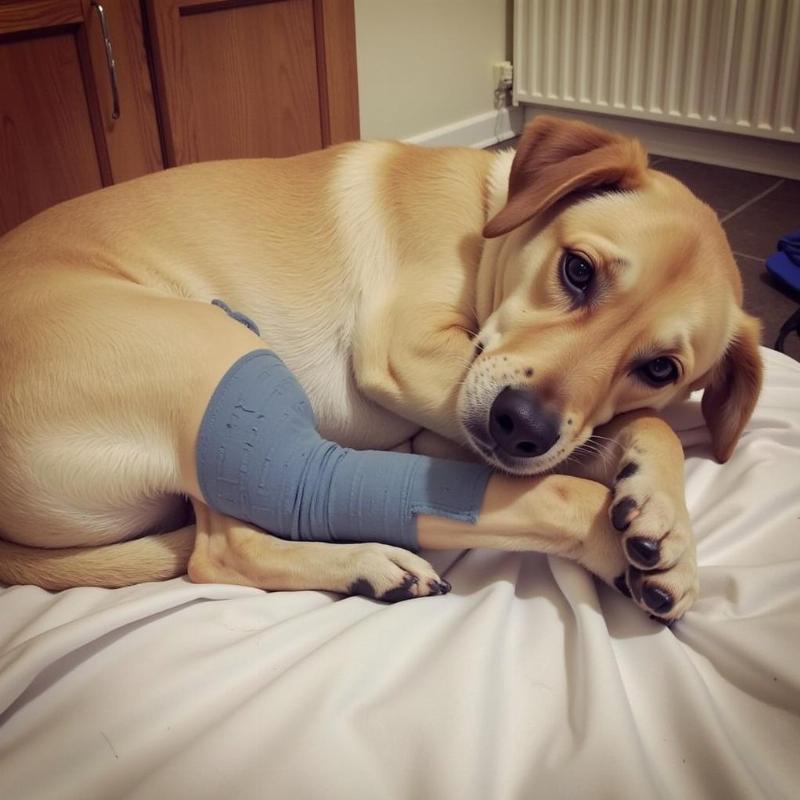Wet-to-dry bandages are sometimes used in veterinary medicine to help debride wounds, meaning to remove dead or damaged tissue. It’s important to understand that applying a wet-to-dry bandage on your dog is not a DIY project. This technique requires proper veterinary guidance to ensure effectiveness and prevent complications. This article will provide essential information about wet-to-dry bandages for dogs, focusing on the importance of veterinary supervision and proper wound care.
While the term “wet-to-dry bandage” might seem self-explanatory, the application and management of this type of bandage are more nuanced than simply applying a wet bandage and letting it dry. Why is veterinary oversight so crucial? Because incorrect application can lead to further tissue damage, infection, and prolonged healing times. Your veterinarian will assess your dog’s wound, determine if a wet-to-dry bandage is the appropriate treatment, and instruct you on the precise technique.
Understanding Wet-to-Dry Bandages
Wet-to-dry bandages work by adhering to the necrotic (dead) tissue within a wound. As the bandage dries, it pulls away this dead tissue, promoting the growth of healthy new tissue. This method is typically used for deep wounds, open wounds, or wounds with significant drainage. However, it’s crucial to understand that this method can be painful and is not suitable for all types of wounds. Your veterinarian will determine the best course of action based on the nature and severity of your dog’s injury.
Why Veterinary Supervision is Essential
Applying a wet-to-dry bandage incorrectly can lead to serious consequences. Applying too tightly can restrict blood flow and further damage the tissue. Too loose, and the bandage won’t effectively debride the wound. Furthermore, the frequency of bandage changes and the type of solution used to moisten the gauze are critical factors that your veterinarian will determine based on your dog’s individual needs.
Proper Wound Care at Home
Your veterinarian will provide specific instructions on how to care for the bandaged area at home. This typically includes keeping the bandage clean and dry, preventing your dog from licking or chewing at the bandage, and monitoring for any signs of infection, such as increased redness, swelling, or discharge.
 Dog Resting Comfortably with a Bandage
Dog Resting Comfortably with a Bandage
Alternative Wound Management Techniques
Wet-to-dry bandaging is not the only option for wound management in dogs. Other methods, such as hydrocolloid dressings, enzymatic debridement, and surgical closure, may be more appropriate depending on the wound’s characteristics. Your veterinarian will discuss all available options and recommend the best approach for your dog’s specific situation.
Signs of Infection and When to Contact Your Vet
Even with proper care, infections can sometimes occur. Be vigilant for any changes in the wound or surrounding area. If you notice increased redness, swelling, discharge, a foul odor, or if your dog seems to be in pain, contact your veterinarian immediately.
Conclusion
Wet-to-dry bandages can be a valuable tool in wound management for dogs, but they require careful application and monitoring under the guidance of a veterinarian. Never attempt to apply a wet-to-dry bandage without consulting your veterinarian first. Their expertise will ensure your dog receives the proper care and avoids potential complications, promoting a safe and effective healing process. By working closely with your veterinarian and following their instructions diligently, you can help your dog recover comfortably and completely.
FAQ
- How often should a wet-to-dry bandage be changed? This depends on your veterinarian’s assessment of your dog’s individual needs.
- What type of solution should be used to moisten the gauze? Your veterinarian will specify the appropriate solution, which could be sterile saline or another prescribed solution.
- Is it normal for the bandage to stick to the wound? Yes, the bandage is designed to adhere to the necrotic tissue to aid in debridement.
- What should I do if my dog chews at the bandage? Use an Elizabethan collar (cone) to prevent your dog from accessing the bandage.
- Can I use a wet-to-dry bandage on any type of wound? No, this method is not suitable for all wounds. Consult your veterinarian for appropriate wound care.
- What are the signs of infection? Increased redness, swelling, discharge, a foul odor, and pain are all potential signs of infection.
- How long will my dog need to wear a wet-to-dry bandage? The duration of treatment varies depending on the wound’s healing progress.
Introducing Beautdogs.us
Beautdogs.us is your premier online resource for all things dog-related in the US. We provide expert advice on dog breeds, care, and product recommendations. Whether you’re a first-time dog owner or a seasoned expert, Beautdogs.us offers reliable and engaging information to help you provide the best possible care for your canine companion. Connect with us for personalized support at [email protected] or call us at +1 501-555-7529.